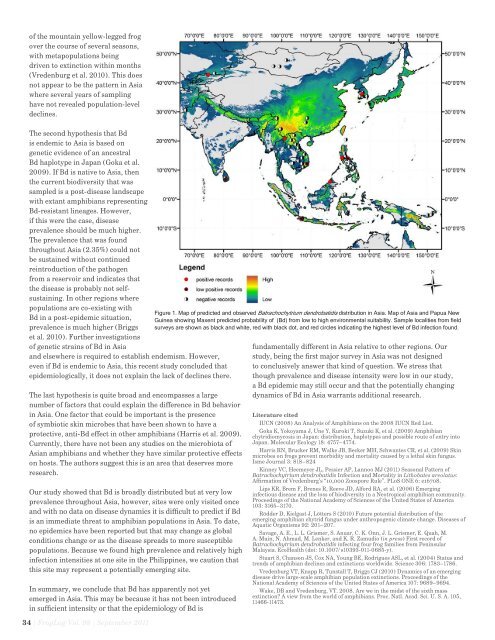download the PDF here - Amphibian Specialist Group
download the PDF here - Amphibian Specialist Group
download the PDF here - Amphibian Specialist Group
You also want an ePaper? Increase the reach of your titles
YUMPU automatically turns print PDFs into web optimized ePapers that Google loves.
of <strong>the</strong> mountain yellow-legged frog<br />
over <strong>the</strong> course of several seasons,<br />
with metapopulations being<br />
driven to extinction within months<br />
(Vredenburg et al. 2010). This does<br />
not appear to be <strong>the</strong> pattern in Asia<br />
w<strong>here</strong> several years of sampling<br />
have not revealed population-level<br />
declines.<br />
The second hypo<strong>the</strong>sis that Bd<br />
is endemic to Asia is based on<br />
genetic evidence of an ancestral<br />
Bd haplotype in Japan (Goka et al.<br />
2009). If Bd is native to Asia, <strong>the</strong>n<br />
<strong>the</strong> current biodiversity that was<br />
sampled is a post-disease landscape<br />
with extant amphibians representing<br />
Bd-resistant lineages. However,<br />
if this were <strong>the</strong> case, disease<br />
prevalence should be much higher.<br />
The prevalence that was found<br />
throughout Asia (2.35%) could not<br />
be sustained without continued<br />
reintroduction of <strong>the</strong> pathogen<br />
from a reservoir and indicates that<br />
<strong>the</strong> disease is probably not selfsustaining.<br />
In o<strong>the</strong>r regions w<strong>here</strong><br />
populations are co-existing with<br />
Bd in a post-epidemic situation,<br />
prevalence is much higher (Briggs<br />
et al. 2010). Fur<strong>the</strong>r investigations<br />
of genetic strains of Bd in Asia<br />
and elsew<strong>here</strong> is required to establish endemism. However,<br />
even if Bd is endemic to Asia, this recent study concluded that<br />
epidemiologically, it does not explain <strong>the</strong> lack of declines <strong>the</strong>re.<br />
The last hypo<strong>the</strong>sis is quite broad and encompasses a large<br />
number of factors that could explain <strong>the</strong> difference in Bd behavior<br />
in Asia. One factor that could be important is <strong>the</strong> presence<br />
of symbiotic skin microbes that have been shown to have a<br />
protective, anti-Bd effect in o<strong>the</strong>r amphibians (Harris et al. 2009).<br />
Currently, <strong>the</strong>re have not been any studies on <strong>the</strong> microbiota of<br />
Asian amphibians and whe<strong>the</strong>r <strong>the</strong>y have similar protective effects<br />
on hosts. The authors suggest this is an area that deserves more<br />
research.<br />
Our study showed that Bd is broadly distributed but at very low<br />
prevalence throughout Asia, however, sites were only visited once<br />
and with no data on disease dynamics it is difficult to predict if Bd<br />
is an immediate threat to amphibian populations in Asia. To date,<br />
no epidemics have been reported but that may change as global<br />
conditions change or as <strong>the</strong> disease spreads to more susceptible<br />
populations. Because we found high prevalence and relatively high<br />
infection intensities at one site in <strong>the</strong> Philippines, we caution that<br />
this site may represent a potentially emerging site.<br />
In summary, we conclude that Bd has apparently not yet<br />
emerged in Asia. This may be because it has not been introduced<br />
in sufficient intensity or that <strong>the</strong> epidemiology of Bd is<br />
34 | FrogLog Vol. 98 | September 2011<br />
Figure 1. Map of predicted and observed Batrachochytrium dendrobatidis distribution in Asia. Map of Asia and Papua New<br />
Guinea showing Maxent predicted probability of (Bd) from low to high environmental suitability. Sample localities from field<br />
surveys are shown as black and white, red with black dot, and red circles indicating <strong>the</strong> highest level of Bd infection found.<br />
fundamentally different in Asia relative to o<strong>the</strong>r regions. Our<br />
study, being <strong>the</strong> first major survey in Asia was not designed<br />
to conclusively answer that kind of question. We stress that<br />
though prevalence and disease intensity were low in our study,<br />
a Bd epidemic may still occur and that <strong>the</strong> potentially changing<br />
dynamics of Bd in Asia warrants additional research.<br />
Literature cited<br />
IUCN (2008) An Analysis of <strong>Amphibian</strong>s on <strong>the</strong> 2008 IUCN Red List.<br />
Goka K, Yokoyama J, Une Y, Kuroki T, Suzuki K, et al. (2009) <strong>Amphibian</strong><br />
chytridiomycosis in Japan: distribution, haplotypes and possible route of entry into<br />
Japan. Molecular Ecology 18: 4757–4774.<br />
Harris RN, Brucker RM, Walke JB, Becker MH, Schwantes CR, et al. (2009) Skin<br />
microbes on frogs prevent morbidity and mortality caused by a lethal skin fungus.<br />
Isme Journal 3: 818–824<br />
Kinney VC, Heemeyer JL, Pessier AP, Lannoo MJ (2011) Seasonal Pattern of<br />
Batrachochytrium dendrobatidis Infection and Mortality in Lithobates areolatus:<br />
Affirmation of Vredenburg’s “10,000 Zoospore Rule”. PLoS ONE 6: e16708.<br />
Lips KR, Brem F, Brenes R, Reeve JD, Alford RA, et al. (2006) Emerging<br />
infectious disease and <strong>the</strong> loss of biodiversity in a Neotropical amphibian community.<br />
Proceedings of <strong>the</strong> National Academy of Sciences of <strong>the</strong> United States of America<br />
103: 3165–3170.<br />
Rödder D, Kielgast J, Lötters S (2010) Future potential distribution of <strong>the</strong><br />
emerging amphibian chytrid fungus under anthropogenic climate change. Diseases of<br />
Aquatic Organisms 92: 201–207.<br />
Savage, A. E., L. L. Grismer, S. Anuar, C. K. Onn, J. L. Grismer, E. Quah, M.<br />
A. Muin, N. Ahmad, M. Lenker, and K. R. Zamudio (in press) First record of<br />
Batrachochytrium dendrobatidis infecting four frog families from Peninsular<br />
Malaysia. EcoHealth (doi: 10.1007/s10393-011-0685-y).<br />
Stuart S, Chanson JS, Cox NA, Young BE, Rodrigues ASL, et al. (2004) Status and<br />
trends of amphibian declines and extinctions worldwide. Science 306: 1783–1786.<br />
Vredenburg VT, Knapp R, Tunstall T, Briggs CJ (2010) Dynamics of an emerging<br />
disease drive large-scale amphibian population extinctions. Proceedings of <strong>the</strong><br />
National Academy of Sciences of <strong>the</strong> United States of America 107: 9689–9694.<br />
Wake, DB and Vredenburg, VT. 2008. Are we in <strong>the</strong> midst of <strong>the</strong> sixth mass<br />
extinction? A view from <strong>the</strong> world of amphibians. Proc. Natl. Acad. Sci. U. S. A. 105,<br />
11466-11473.
















